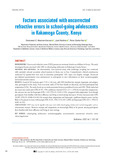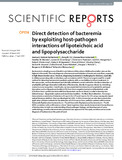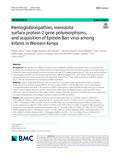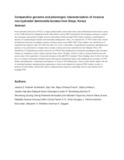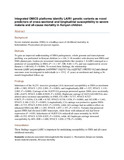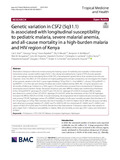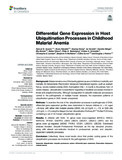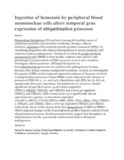Search
Now showing items 1-8 of 8
Nonsynonymous amino acid changes in the α-chain of complement component 5 influence longitudinal susceptibility to Plasmodium falciparum infections and severe malarial anemia in kenyan children
(Frontier in genetics, 2022-08-14)
Background: Severe malarial anemia (SMA; Hb < 5.0 g/dl) is a leading cause of childhood morbidity and mortality in holoendemic Plasmodium falciparum transmission regions such as western Kenya.
Methods: We investigated ...
Direct detection of bacteremia by exploiting host-pathogen interactions of lipoteichoic acid and lipopolysaccharide
(Scientific Reports, 2019-04-17)
Bacteremia is a leading cause of death in sub-Saharan Africa where childhood mortality rates are the highest in the world. The early diagnosis of bacteremia and initiation of treatment saves lives, especially in high-disease ...
Human NCR3 gene variants rs2736191 and rs11575837 alter longitudinal risk for development of pediatric malaria episodes and severe malarial anemia
(Springer Link, 2023-09-13)
Background
Plasmodium falciparum malaria is a leading cause of pediatric morbidity and mortality in holoendemic transmission areas. Severe malarial anemia [SMA, hemoglobin (Hb) < 5.0 g/dL in children] is the most common ...
Comparative genomic and phenotypic characterization of invasive non-typhoidal Salmonella isolates from Siaya, Kenya
(PLOS ONE, 2021-01-01)
Non-typhoidal Salmonella (NTS) is a major global health concern that often causes bloodstream infections in areas of the world affected by malnutrition and comorbidities such as HIV and malaria. Developing a strategy to ...
Integrated OMICS platforms identify LAIR1 genetic variants as novel predictors of cross-sectional and longitudinal susceptibility to severe malaria and all-cause mortality in Kenyan children
(EBioMedicine, 2019-07-02)
Background
Severe malarial anaemia (SMA) is a leading cause of childhood mortality in holoendemic Plasmodium falciparum regions.
Methods
To gain an improved understanding of SMA pathogenesis, whole genome and transcriptome ...
Genetic variation in CSF2 (5q31.1) is associated with longitudinal susceptibility to pediatric malaria, severe malarial anemia, and all-cause mortality in a high-burden malaria and HIV region of Kenya
(Tropical Medicine and Health, 2022-06-25)
Plasmodium falciparum infections remain among the leading causes of morbidity and mortality in holoendemic transmission areas. Located within region 5q31.1, the colony-stimulating factor 2 gene (CSF2) encodes granulocyte ...
Differential Gene Expression in Host Ubiquitination Processes in Childhood Malarial Anemia
(Frontiers in Genetics, 2021-11-22)
Background: Malaria remains one of the leading global causes of childhood morbidity and mortality. In holoendemic Plasmodium falciparum transmission regions, such as western Kenya, severe malarial anemia [SMA, hemoglobin ...
Ingestion of hemozoin by peripheral blood mononuclear cells alters temporal gene expression of ubiquitination processes
(Biochemistry and Biophysics Reports, 2022-01-11)
Plasmodium falciparum (Pf) malaria is among the leading causes of childhood morbidity and mortality worldwide. During a natural infection, ingestion of the malarial parasite product, hemozoin (PfHz), by circulating phagocytic ...

